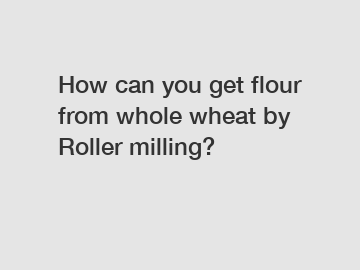How can you get flour from whole wheat by Roller milling?
When it comes to baking, flour is an essential ingredient that serves as the foundation of many delicious recipes. And while there are various types of flour available on the market, whole wheat flour is a popular choice for its nutty flavor and nutritional benefits. But have you ever wondered how flour is actually produced from whole wheat? One of the most common methods used in the industry is roller milling.
Roller milling is a process that involves passing whole wheat grains through a series of rollers to break them down into fine particles, resulting in the production of flour. This method is preferred by many because it allows for the extraction of the bran and germ, which are rich in nutrients and fiber, while also producing a high-quality flour that is perfect for baking.
The process of roller milling begins with the cleaning of the wheat grains to remove any impurities or foreign material. Once the grains are cleaned, they are tempered to adjust the moisture content, making them easier to mill. The tempered grains are then passed through a series of rollers that gradually decrease in size, crushing the grains and separating the bran, germ, and endosperm.

As the grains pass through the rollers, the bran and germ are separated from the endosperm, which is the starchy part of the grain that is used to make flour. The bran and germ are rich in nutrients and fiber, making them a valuable byproduct that can be used in various other products such as animal feed or nutritional supplements.
The endosperm, now in the form of a fine powder, is collected and sifted to remove any remaining bran or germ particles. The resulting flour is then packaged and ready for distribution to consumers. Roller milling allows for the production of a high-quality whole wheat flour that retains all the nutritional benefits of the whole grain, making it a popular choice for health-conscious individuals.
One of the key advantages of roller milling is its efficiency in producing high-quality flour. The process allows for the extraction of the bran and germ while producing a fine, consistent flour that is perfect for baking. This results in a flour that is rich in nutrients and fiber, making it a healthier option compared to refined white flour.
Additionally, roller milling is a versatile process that can be adjusted to produce different types of flour with varying levels of extraction. This allows for the production of whole wheat flour, as well as refined flours such as all-purpose flour or pastry flour. This versatility makes roller milling an ideal choice for commercial flour producers who need to meet the diverse needs of their customers.
In conclusion, roller milling is a highly efficient and versatile process for producing flour from whole wheat grains. The process allows for the extraction of the bran and germ, producing a high-quality flour that is rich in nutrients and fiber. Roller milling is a popular choice for commercial flour producers due to its efficiency, versatility, and ability to produce high-quality flour that is perfect for baking. So the next time you bake a delicious loaf of whole wheat bread or a batch of hearty muffins, remember that roller milling played a crucial role in bringing that flour to your kitchen.
If you are looking for more details, kindly visit corn processing equipment installation, is flour mill business profitable, is flour business profitable.
356
0
0


Comments
All Comments (0)